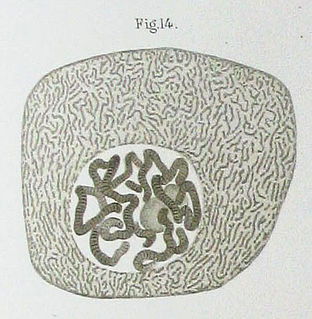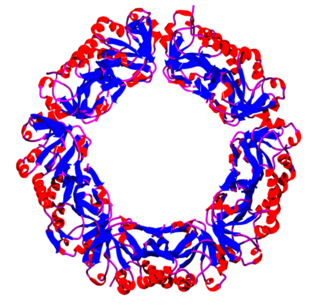Related Research Articles

A circadian rhythm is a natural, internal process that regulates the sleep–wake cycle and repeats on each rotation of the Earth roughly every 24 hours. It can refer to any biological process that displays an endogenous, entrainable oscillation of about 24 hours. These 24-hour rhythms are driven by a circadian clock, and they have been widely observed in plants, animals, fungi, and cyanobacteria.
Psychrophiles or cryophiles are extremophilic organisms that are capable of growth and reproduction in low temperatures, ranging from −20 °C to +10 °C. They are found in places that are permanently cold, such as the polar regions and the deep sea. They can be contrasted with thermophiles, which are organisms that thrive at unusually high temperatures. Psychrophile is Greek for 'cold-loving'.

Polytene chromosomes are large chromosomes which have thousands of DNA strands. They provide a high level of function in certain tissues such as salivary glands of insects
A circadian clock, or circadian oscillator, is a biochemical oscillator that cycles with a stable phase and is synchronized with solar time.

The lunar effect is a purported unproven correlation between specific stages of the roughly 29.5-day lunar cycle and behavior and physiological changes in living beings on Earth, including humans. In some cases the purported effect may depend on external cues, such as the amount of moonlight. In other cases, such as the approximately monthly cycle of menstruation in humans, the coincidence in timing reflects no known lunar influence.
Intrinsically photosensitive retinal ganglion cells (ipRGCs), also called photosensitive retinal ganglion cells (pRGC), or melanopsin-containing retinal ganglion cells (mRGCs), are a type of neuron in the retina of the mammalian eye. The presence of ipRGCs were first noted in 1923 when rodless, coneless mice still responded to a light stimulus through pupil constriction, suggesting that rods and cones are not the only light-sensitive neurons in the retina. It wasn't until the 1980s that advancements in research on these cells began. Recent research has shown that these retinal ganglion cells, unlike other retinal ganglion cells, are intrinsically photosensitive due to the presence of melanopsin, a light-sensitive protein. Therefore they constitute a third class of photoreceptors, in addition to rod and cone cells.

The Chironomidae comprise a family of nematoceran flies with a global distribution. They are closely related to the Ceratopogonidae, Simuliidae, and Thaumaleidae. Many species superficially resemble mosquitoes, but they lack the wing scales and elongated mouthparts of the Culicidae. An example of mosquito-resembling species is Tokunagayusurika akamusi.

Belgica antarctica, the Antarctic midge, is a species of flightless midge, endemic to the continent of Antarctica. At 2–6 mm (0.079–0.24 in) long, it is the largest purely terrestrial animal native to the continent, as well as its only insect. It also has the smallest known insect genome as of 2014, with only 99 million base pairs of nucleotides. It is the only insect that can survive year-round in Antarctica.

Peroxiredoxins are a ubiquitous family of antioxidant enzymes that also control cytokine-induced peroxide levels and thereby mediate signal transduction in mammalian cells. The family members in humans are PRDX1, PRDX2, PRDX3, PRDX4, PRDX5, and PRDX6. The physiological importance of peroxiredoxins is illustrated by their relative abundance.

CLOCK or Clock is a gene encoding a basic helix-loop-helix-PAS transcription factor that is believed to affect both the persistence and period of circadian rhythms.

FBXL3 is a gene in humans and mice that encodes the F-box/LRR-repeat protein 3 (FBXL3). FBXL3 is a member of the F-box protein family, which constitutes one of the four subunits in the SCF ubiquitin ligase complex.

RAR-related orphan receptor gamma (RORγ) is a protein that in humans is encoded by the RORC gene. RORγ is member of the nuclear receptor family of transcription factors. It is mainly expressed in immune cells and it also regulates circadian rhythms. It may be involved in the progression of certain types of cancer.

Tropomodulin-3 is a protein that in humans is encoded by the TMOD3 gene.
Clunio is a genus of non-biting midges in the subfamily Orthocladiinae of the bloodworm family (Chironomidae). All species in the genus are marine. They are found in the intertidal zone of many coasts worldwide. The species Clunio marinus is a long-standing model system in Chronobiology and its genome has been sequenced. Clunio species can be dispersed widely by hitch-hiking on sea-turtles, feeding on algae growing on their carapace.

Aryl hydrocarbon receptor nuclear translocator-like protein 1 (ARNTL) or Brain and Muscle ARNT-Like 1 (BMAL1) is a protein that in humans is encoded by the Bmal1 gene, also known as ARNTL, MOP3, and, less commonly, BHLHE5, BMAL, BMAL1C, JAP3, PASD3, and TIC.

A Per-Arnt-Sim (PAS) domain is a protein domain found in all kingdoms of life. Generally, the PAS domain acts as a molecular sensor, whereby small molecules and other proteins associate via binding of the PAS domain. Due to this sensing capability, the PAS domain has been shown as the key structural motif involved in protein-protein interactions of the circadian clock, and it is also a common motif found in signaling proteins, where it functions as a signaling sensor.

Polypedilum is a genus of non-biting midges in the subfamily Chironominae of the bloodworm family Chironomidae. This is probably the most species-rich of all chironomid genera. Larvae of Polypedilum may also be among the most abundant invertebrates in euthrophic ponds, reaching densities of up to 1200 larvae per square meter.
Chironomus annularius is a species of non-biting midge in the family Chironomidae. It is usually found in regions with bodies of fresh water but can be found in almost every environment. It tends to form "hotspots" around specific areas. The species is distinguished by the size of its chromosomes and the lack of a proboscis.

Tokunagayusurika akamusi is a midge fly species of the family Chironomidae, commonly called "nonbiting midges" or "lake flies."
References
- ↑ Kaiser, TS; D Neumann; DG Heckel; TU Berendonk (2010). "Strong genetic differentiation and postglacial origin of populations in the marine midge Clunio marinus (Chironomidae, Diptera)". Molecular Ecology. 19 (14): 2845–2857. doi:10.1111/j.1365-294X.2010.04706.x. hdl: 11858/00-001M-0000-002C-0516-3 . PMID 20584134.
- ↑ Neumann, D (1966). "Die lunare und tägliche Schlüpfperiodik der Mücke Clunio - Steuerung und Abstimmung auf die Gezeitenperiodik". Zeitschrift für Vergleichende Physiologie. 53 (1): 1–61. doi:10.1007/BF00343045.
- ↑ Kaiser, TS; DG Heckel (2012). "Genetic Architecture of Local Adaptation in Lunar and Diurnal Emergence Times of the Marine Midge Clunio marinus (Chironomidae, Diptera)". PLOS ONE. 7 (2): e32092. doi:10.1371/journal.pone.0032092. PMC 3285202 . PMID 22384150.
- ↑ Kaiser, Tobias S.; Poehn, Birgit; Szkiba, David; Preussner, Marco; Sedlazeck, Fritz J.; Zrim, Alexander; Neumann, Tobias; Nguyen, Lam-Tung; Betancourt, Andrea J. (2016). "The genomic basis of circadian and circalunar timing adaptations in a midge". Nature. 540 (7631): 69–73. doi:10.1038/nature20151. PMC 5133387 . PMID 27871090.
- ↑ Kaiser, Tobias S.; Poehn, Birgit; Szkiba, David; Preussner, Marco; Sedlazeck, Fritz J.; Zrim, Alexander; Neumann, Tobias; Nguyen, Lam-Tung; Betancourt, Andrea J. (2016). "The genomic basis of circadian and circalunar timing adaptations in a midge". Nature. 540 (7631): 69–73. doi:10.1038/nature20151. PMC 5133387 . PMID 27871090.